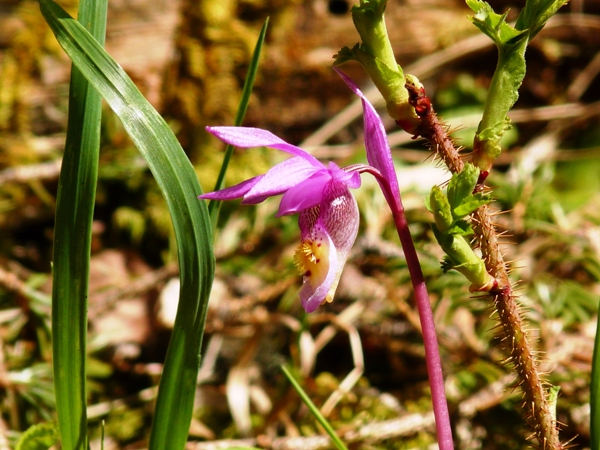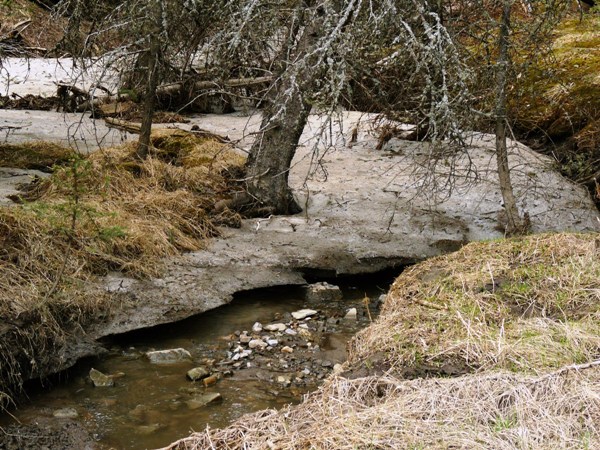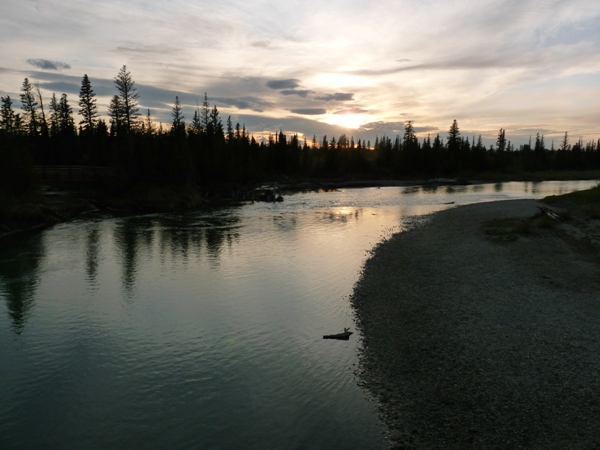|
MIGRATION RESEARCH FOUNDATION |
||||||||||||||||||||||||||||||||||||||||||||||||||||||||||||||||||||||||||||||||||||||||||||||||||||||||||||||||||||||||||||||||||||||||||||||||||||||||||||||||||||||||||||||||||||||||||||||||||||||||||||||||||||||||||||||
After three years of doing my Birdathon while traveling (Switzerland in 2009, Toronto in 2010, southern Quebec in 2011), I decided it was time to do it closer to home again for a change. Although I did Alberta-based Birdathons in my first two years living in the province, both 2007 and 2008 had a substantial prairie focus; for this year I decided to concentrate instead on sites within an hour (roughly 100 km) of Calgary. I figured that such a route might yield 120-125 species and ended up with 126, so perhaps I'm getting to know the area quite well (although to be fair I came across several birds I was not expecting, and as always on days like this had some surprising misses). Read on for details of the day...
I had been planning for Osprey to be my first bird of the day, but my local American Robins and White-throated Sparrows had other ideas, singing in the dark as I left home. So the Osprey nesting along the Bow River west of downtown Calgary became #3 instead - still a nice way to start. As the sun rose, I took in my first view of the mountains from Glenbow Ranch Provincial Park, and boosted my count to 16 species with various common birds ranging from Black-capped Chickadee to Vesper Sparrow. Another quick stop a bit further west at Cochrane Ranch yielded my only Belted Kingfisher and Rock Wren of the day, as well as the first of many Savannah Sparrows. From there I headed north on Horse Creek Road, a traditional spot for Yellow Rail and Nelson's Sparrow, both otherwise uncommon in the region. Unfortunately it seems to have been just a bit too early in the season for either species (a challenge I also faced with several others later in the day). I boosted my total to 40 species by the time I reached the end of the road, though ultimately I ended up seeing all of them again elsewhere during my travels.
Heading back south along Grand Valley Road I saw my first Barn Swallow of the day, then turned west on Wildcat Road where I lucked into a few brilliant blue Mountain Bluebirds. My next stop was the Ghost Reservoir, which was calm but awfully quiet in terms of birds. There was one pair of Horned Grebes way out in the middle, and my only Red-necked Grebe of the day even farther away, but the highlight was the active colony of Bank Swallows on the north shore.
As I continued west on Hwy 1A, I spotted an Eastern Kingbird on a fence for my 50th species of the day, and as it turned out it was the only one of its kind I saw anywhere. A quick stop at the Seebe dam produced the expected Cliff Swallow colony, as well as a trio of bachelorette Buffleheads. I spent the next hour and a half in Bow Valley Provincial Park, checking out the Many Springs and Flowing Waters trails. Although it was a bit windy in spots, and also colder than expected (-2), the birding was quite good. At Many Springs I saw my first of only two Great Blue Herons of the day, plus a Warbling Vireo, Townsend's Warbler, and Dusky Flycatcher.
Because of the wind, I considered skipping the Flowing Waters trail, but fortunately I decided to give it a try regardless. A scurrying Sora, skulking MacGillivray's Warbler, and a couple of Northern Waterthrushes belting out their songs were reward enough. However, the highlight of the day was coming across a feeding frenzy of White-winged Crossbills along the river. There were about 45 of them - on the ground, at eye level, way up above ... all gorging on spruce cones. It's been more than a decade since I last stumbled across a scene like this, and sure enough, they were again pretty oblivious to me.
Although I know that heading into Banff can be a bit of a time sink on a day like this, it's just so hard to resist the lure of the mountains, especially when the weather is so nice. I decided to focus my efforts primarily at Vermilion Lakes, which have rarely disappointed in the past. There were relatively few ducks on the water, but the woods at the end of the road produced nicely, with the only Swainson's Thrush and Orange-crowned Warbler of the day, plus the first of surprisingly many Three-toed Woodpeckers.
Heading back east out of the mountains, I thought it would be worth checking out Barrier Lake in Kananaskis and then heading east through Sibbald Flats on Hwy 68. At Barrier Lake I was painfully reminded of the problems with doing a Birdathon on a long weekend, let alone one with beautiful weather - the parking lot was overflowing, with the road lined with cars all the way out to the highway! I bailed on that, only to encounter a car rally blocking some of the most interesting spots along Hwy 68. The only new species I added was Common Merganser, bringing me to 75 for the day around noon.
My next stop was Brown-Lowery Provincial Park, an interesting parcel of moist spruce-dominated forest that I first visited on my 2007 Birdathon. I remembered finding Varied Thrush there on that occasion and was hoping for a repeat, but it was not to be. However, other pleasant surprises were in store for me. Scattered around the park were 5 Cape May Warblers, a species I haven't seen in Alberta since 2008. I also found another 4 Three-toed Woodpeckers, making them the most abundant woodpecker of the day for me, also quite remarkable given that I last saw them in the province in 2009. Topping the list though was a fly-over Evening Grosbeak, my first ever in Alberta! The park also yielded my only Brown Creeper, Pacific Wren, and Ovenbird of the day. Not that these birds came easily - the hike to the far end of the park and back was around 7 km (for that matter, despite driving to a number of locations, I estimate that I walked 18-20 km over the course of the day).
Between Brown-Lowery and Frank Lake, I added Merlin in Turner Valley and House Finch in High River. I was counting on Frank Lake to give my list a big boost with marsh species, and for the most part it delivered. In a bit under an hour, I added 20 new birds for the day to reach 105. A nice group of 18 Black-bellied Plovers (the first I've sen here) and a raft of 22 Red-necked Phalaropes were pleasant surprises, offsetting the general scarcity of shorebirds (not even a Willet or American Avocet to be found - only a few Black-necked Stilts and Wilson's Phalaropes). Similarly, Forster's and Common Terns were in good view, but Black Terns were strangely missing. However, the most impressive sight was the giant group of White-faced Ibis, mixed in with the Franklin's Gull colony - at the peak of activity, I saw over 120 ibis at once.
At a large wetland along Hwy 547, I finally found Willet and American Avocet, and as a bonus I got Marbled Godwit, Stilt Sandpiper, Baird's Sandpiper, Semipalmated Sandpiper, and Semipalmated Sandpiper at the same location - on a day when shorebirds seemed unusually scarce, this was by far the best spot for them. I was counting on Weed Lake to deliver some more, but it was unusually poor on the shorebirds front, although the density of gulls, ducks, and grebes was as spectacular as ever.
I took a loop north of the Trans-Canada Highway, hoping that the various sloughs in the area would produce some more shorebirds, but it was tough going. A few more phalaropes, snipes and avocets, but the only new species I was able to add were Greater Yellowlegs and Common Grackle. I decided to wrap up my day at the Weaselhead Natural Area in Calgary, figuring that at least some forest birds might give an evening song or two - and after all, I had a long list of candidates still missing from my list. A Blue Jay called as I entered the parking lot, a Spotted Towhee called as I descended the slope, and "Old Faithful" (an Eastern Phoebe, not the Yellowstone geyser!) was on territory as always by the second footbridge, taking me to 120 for the day with an hour or so to go until sunset. To my surprise, one of the local Calliope Hummingbirds was already back ... 121. On the south slope, the Least Flycatchers were still going strong, as expected ... 122. Further east along the slope, a Hermit Thrush gave an evening song ... 123. I strained my ears for Swamp Sparrow, Wilson's Warbler, Veery, Rose-breasted Grosbeak, Red-eyed Vireo, Gray Catbird, and House Wren - all of which I've heard in this area in late May before, but either they aren't quite back yet, or had already settled in for the night. However, I found an American Goldfinch as I headed back up to the parking lot, and as I turned back to look at the sunset, I saw a Bald Eagle fly by ... 125.
I was pretty sure that would be my final total, but when I got home and stepped out on the balcony hoping for the off chance of hearing a House Wren or Gray Catbird from the valley below, I instead heard a Great Horned Owl - and moments later a second one responding to it! The conversation continued for several minutes, to the consternation of the several local American Robins clucking agitatedly. A remarkable end to the day, given that I've lived here for 5+ years and have only observed Great Horned Owl on three previous occasions! My total of 126 species included 18 waterfowl, 17 shorebirds, 11 sparrows, and 10 warblers - the latter a particularly pleasant surprise for southern Alberta. The only major groups missed entirely were galliformes and mimids. The big species misses fall into three categories - those that I saw within minutes of home the day before (Gray Partridge, Downy and Hairy Woodpecker, Violet-Green Swallow, House Wren, Cedar Waxwing), those that have been back for a while but were inexplicably difficult to find (Pied-billed Grebe, American White Pelican, Northern Harrier, Least Sandpiper, Black Tern, Horned Lark), and migrants that are just beginning to arrive and will no doubt be easier to find in the days that follow (Western Wood-Pewee, Western Kingbird, Red-eyed Vireo, Veery, Gray Catbird, Western Tanager, Rose-breasted Grosbeak, Baltimore Oriole). Chances are that following this same route a week later could net another ten or so species; perhaps more if some of the less productive sections of the route are replaced with other options ... something to consider next year perhaps!. If you have made it this far, I trust you've enjoyed the report - and I hope that if you haven't already done so, you will consider contributing to my Birdathon. All funds raised are split between the Migration Research Foundation (75%, primarily to support migration monitoring at McGill Bird Observatory), and Bird Studies Canada (25%, dedicated to the Baillie Fund for conservation research), and charitable receipts will be issued to all Canadian donors for next year's tax returns. Donations can be made through the secure online form, or if you prefer to send a cheque, please e-mail me for details. Thank you for your generous support! Calgary area Birdathon --- May 20, 2012 --- List of 126 bird species seen and/or heard
|
















